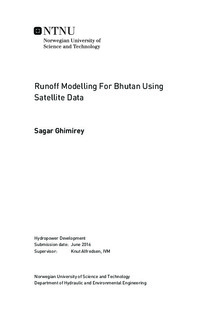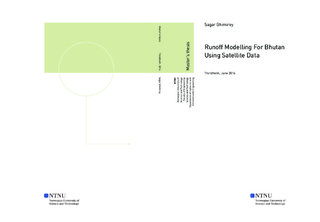| dc.description.abstract | Due to the limitations posed by the difficult terrain and lack of resources to install and manage the hydro-meteorological stations, Bhutan faces challenges related to sparse data network while planning water resource projects in ungauged catchments. Precipitation is an important source of input to predict runoff for an ungauged catchments using some model but, the distribution of the existing rainfall gauges in Bhutan is clustered at lower altitudes and are located in the valleys, which, neither represent well the high spatial variability of precipitation nor they provide information on the climatic conditions of the headwater regions. Therefore, as an alternative, an attempt is made in this study, to predict the precipitation induced runoff using satellite precipitation product for Dangchhu catchment in the Punatsangchhu basin.
TRMM 3B42 version 7 daily precipitation estimates with a spatial resolution of 0.25° x 0.25° was acquired for comparison and evaluation against the ground measurements. The daily CPOD_S of 0.79 on average showed that ability of TRMM to detect precipitation good but the R2 value was low and negative in most of the pixels with small trend of reduction with increasing elevation. On monthly and annual scales, better results were obtained with R2 and RR values ranging from 0.73 to 0.98 and 0.71 to 1 respectively. The monthly and annual data sets performed equally well with no trend of increasing or decreasing R2 with elevation. In all the time scales there was underestimation of precipitation by the TRMM mostly in the southern regions and overestimation in the central and northern regions. Overall, there was a general qualitative match of satellite data with the gauge in terms of timing but there were quantitative differences in all time scales and hence bias correction was necessary.
SHyFT was calibrated and validated for Kerabari catchment in the basin with three input cases; [1] gauge precipitation, [2] BCSE and [3] RSE. There was consistent underestimation of simulated runoff in most years with RSE thereby, indicating the need to adjust the biasness in the satellite estimates. The BCSE and gauge simulated hydrographs were able to match relatively well with the observed hydrographs at Kerabari. Average R2 for the three input cases were 0.78, 0.73, 0.65 respectively. The calibrated model with the input case 1 and 2 was used to simulate flow for and an ungauged catchment (Dangchhu) and for some gauged catchments in the upstream for the period 2003 to 2007. Simulated hydrograph with BCSE was estimating higher flows compared to gauge inputs at Dangchhu and it was otherwise when a new simulation was conducted at Wangdue flow gauging station which has more ground networks. R2 at Wangdue were 0.62 and 0.26 for case 1 and 2. It was learnt that the performance of simulation with input case 1 and 2 was increasing with the increase in catchment size and ground network. Since RSE is underestimating flows and the BCSE is purely dependent on quality and density of gauges, the product selected for study could not be used independently in small catchments therefore other satellite data with much finer resolution should be assessed. | |

